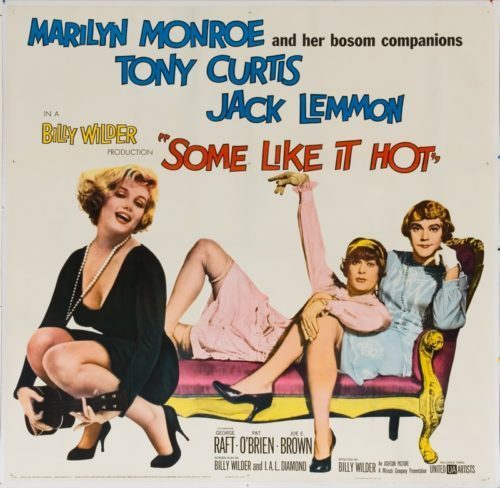
By Heather Babcock
There is a scene in Some Like It Hot (1959) which never fails to elicit rapturous sighs from both my boyfriend and I:
On the run after accidentally witnessing a gangland massacre, musicians Joe (Tony Curtis) and Jerry (Jack Lemmon) are going undercover as “Josephine” and “Daphne”, the newest (and the most stylish) members of an all-girl jazz band. They’re about to board their train to Florida when they spot Sugar (Marilyn Monroe), the band’s voluptuous lead singer and ukulele player. “Look at that! Look how she moves,” Daphne whispers, admiring Sugar’s sumptuous strut. “It’s just like jello on springs!”
My boyfriend’s awe is directed at the devilish wiggle and angelic beauty of Marilyn Monroe, and while I certainly can understand (and share) his admiration, my own sighs are reserved for the gorgeous outfits adorned by Curtis’ haughty and elegant Josephine and Lemmon’s sassy jazz-baby Daphne.
In a 2001 interview with Leonard Maltin, Tony Curtis, who based the refined Josephine on his mother and Grace Kelly, revealed that after he and Jack had unsuccessfully tried on the cast-off dresses of Debbie Reynolds and Norma Shearer, he approached the film’s director/producer Billy Wilder and asked if the famed costume and gown designer Orry-Kelly could custom make their wardrobe. The results were breathtakingly fabulous.
The collaborative effort of Curtis, Lemmon, Orry-Kelly and Wilder to respectfully present Josephine and Daphne as attractive is an important part of why Some Like It Hot has endured some 60 years on. There is no mean spirit here – the movie doesn’t stick two guys in dresses and expect the audience to laugh at them; rather the film’s laughs come from the cast’s delivery of Wilder’s and co-writer I.A.L. Diamond’s smart-as-a-whip dialogue. This is why Some Like It Hot has been often imitated but never duplicated.
Lesbians, gay men, bi-sexual and transgender people can be found in movies made during the 1920s all the way through – and up until – the enforcement of the Motion Picture Production Code: a snazzy looking lesbian couple can be spotted in the infamous speakeasy (bubbles!) scene in 1927’s Wings; in Little Caesar (1931) it’s pretty obvious that Edward G. Robinson’s titular gangster is romantically involved with his flunky, played by George E. Stone (who, not incidentally, has a small role as a gangster in Some Like It Hot); Helen Dickson is a bow-tie wearing, cigar chomping inmate “who likes to wrestle” in the female prison movie Ladies They Talk About (1933) and Blanche Friderici portrays an openly gay writer in The Office Wife (1930). These are just a few examples. Yet after the enforcement of the Motion Picture Production Code in mid-1934, LGBTQ+ characters disappeared from the screen. This is why Some Like It Hot is so (joyfully) surprising. With its open-minded sexuality and subversion of traditional gender roles, the film feels both like a Pre-Code movie and incredibly modern.
In its final twenty minutes or so, Some Like It Hot sets the whole damn Code on fire. When Josephine mounts the stage to plant an open-mouthed kiss on Sugar, the blonde beauty is a bit taken aback but clearly delighted. In the movie’s infamous ending, Jerry removes his Daphne-wig in an attempt to convince his wealthy fiancé (played by the wonderful Joe E. Brown) that he can’t marry him because “I’m a man!”. “Nobody’s perfect!” the obviously still smitten fiancé happily replies. Perhaps he knew all along.
“I always get the fuzzy end of the lollipop!” Sugar laments as she guzzles her bourbon. Sixty years young and counting, Some Like It Hot remains as sizzling as it is sweet.
You must be logged in to post a comment.